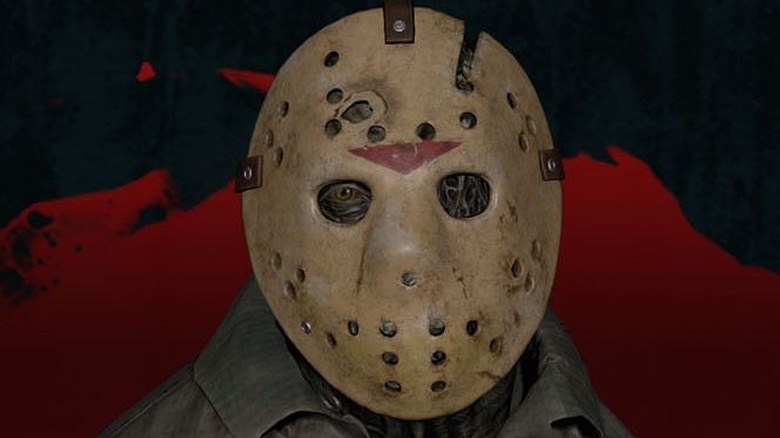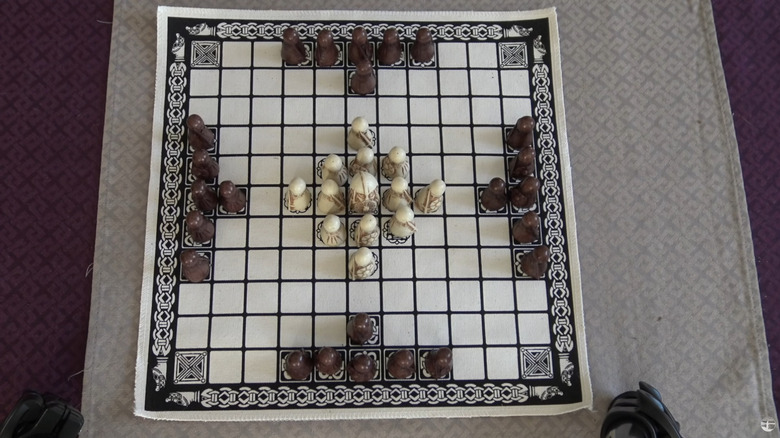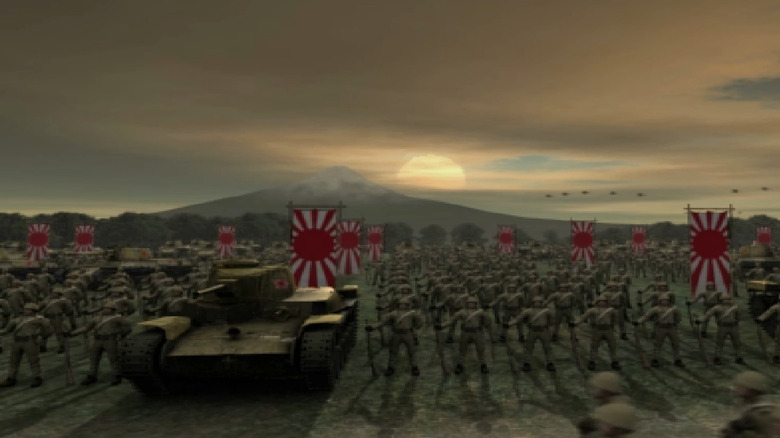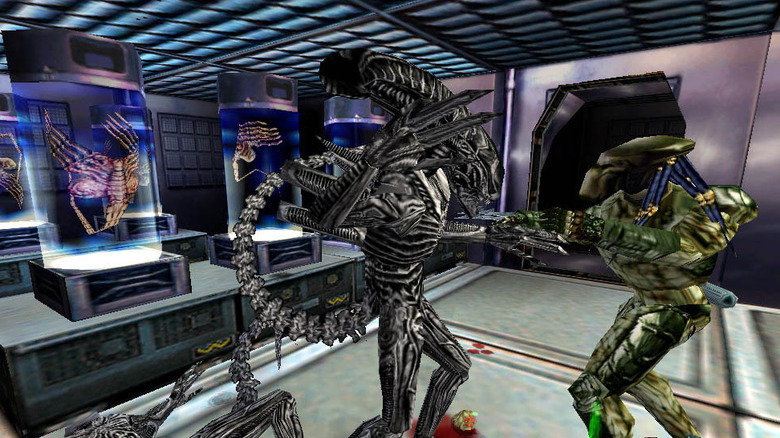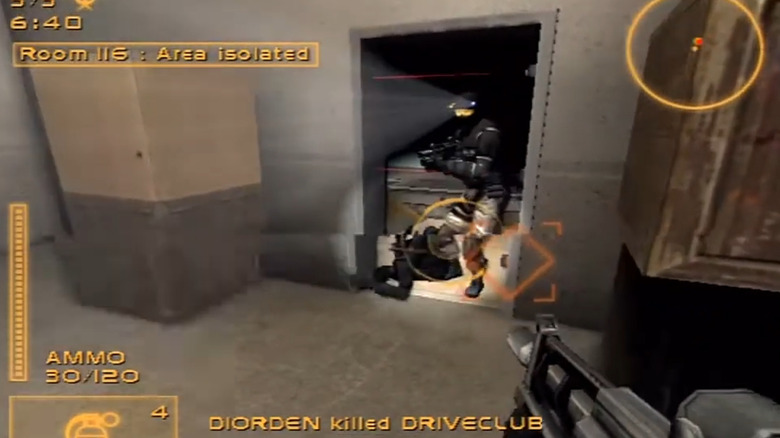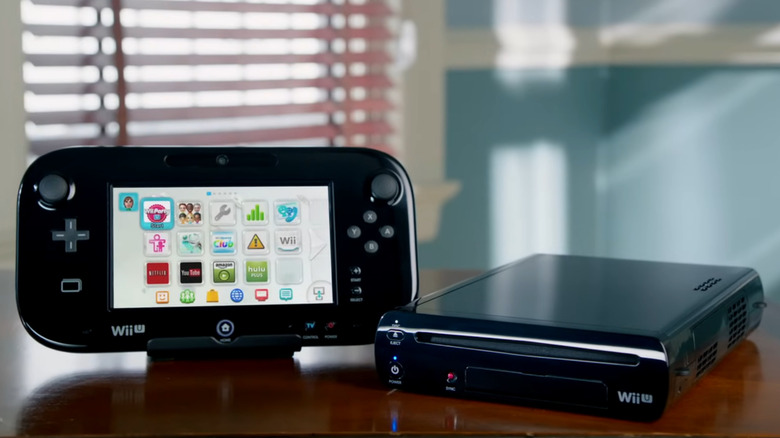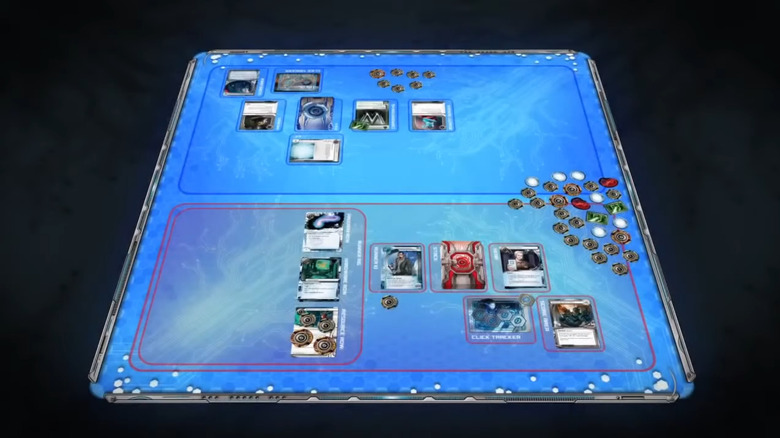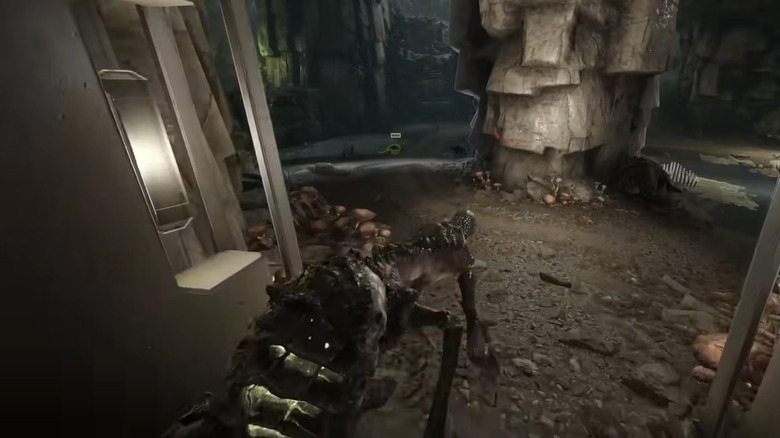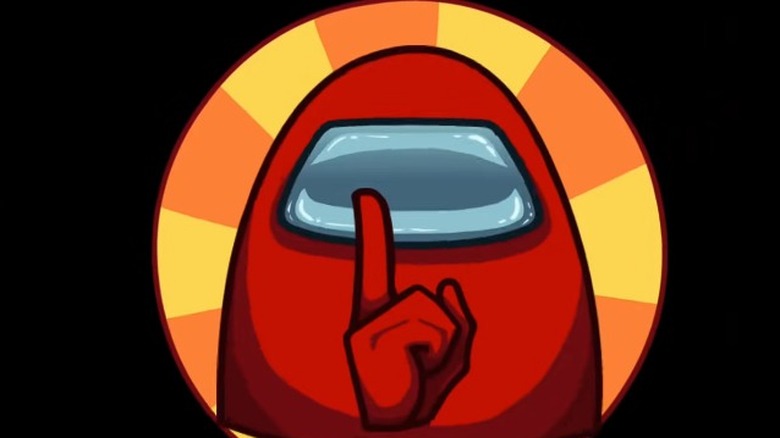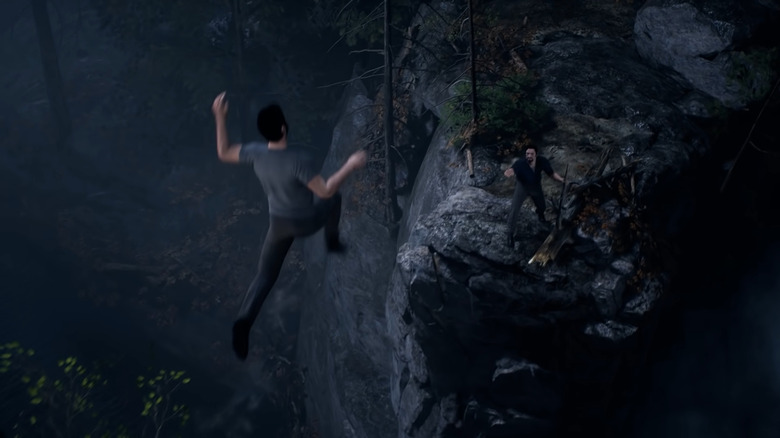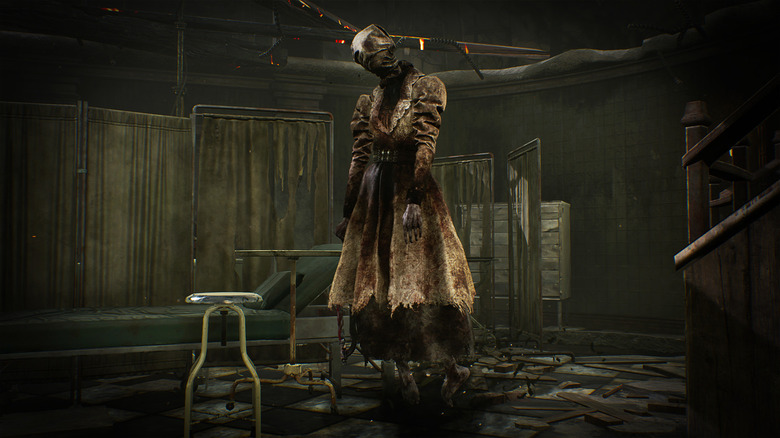The Evolution Of Asymmetrical Games
Plenty of people would agree that games are supposed to be fair, but gamers have long realized that "fair" is often much less important than "balanced." While classic board games like chess and annual competitive titles like "Call of Duty" are always going to be popular, there's a growing demand for the kinds of thrilling experiences that can only be had when fairness is left behind.
Asymmetrical games put their players in completely different situations, with different goals and tools, and often leave them on completely different footings. They set a group of relatively innocent humans against a raging, violent monster, or they force a down-and-out hacker to try and topple the goals of a global megacorporation. In essence, an asymmetrical game is any game that comes pre-packaged with different sets of mechanics for different players or teams. In practice, asymmetrical games can be just about anything.
The genre began its life on tabletops, but video games were quick to experiment with its many possibilities. 1997's "Aliens versus Predator" demonstrated stunning innovation by pitting Marines against extra-terrestrial enemies with vastly superior abilities. More recently, "Among Us" has shown the gaming world the joys of deception, and "Friday the 13th: The Game" has let gamers live out their worst horror movie nightmares. Behavior Interactive's latest project "Meet Your Maker" promises a mixture of cooperation and competition unlike anything you've played before. The evolution of asymmetrical games has already come along way, but in a best case scenario it's just getting started.
Hnefatafl
Asymmetrical video games have been on gamers' radars for a long time now, particularly since the launch of the Wii U (more on that later), but the idea of asymmetric gaming goes back much further than that. Hnefatfl, sometimes just referred to as Tafl, is an asymmetric board game that was once played by Vikings, who said that the gods themselves played the game to relax (via playthepast). That dates asymmetrical gaming at being at least a thousand years old. To the casual observer, Tafl might look like a modified version of chess, where a player protects their king from an invading force. Tafl's subtle differences, however, planted the seed for every asymmetric game we play today.
The two opponents in Tafl not only have different resources but also different goals. The defending player has 12 soldiers and a king, while their opponent vastly outnumbers them with 24 attacking soldiers under their command. (via BoardGameGeek). The king's goal is to make it to the edge of the board to escape the battle, and the attacking soldiers are simply trying to capture him before he can reach his goal. The game's many pieces all follow the same movement rules as a Rook in chess, which makes the game simple to pick up, but its mismatched sides open up a whole new world of possibilities, which is exactly how the game has managed to stick around for all this time.
Axis and Allies
Before the ideas at the heart of Hnefatafl could be translated into digital games, they went through one more metamorphosis. Tabletop war games provide all the excitement of mismatched forces going to battle with some added complexity and a historical draw that really gets the imagination going. The quintessential tabletop war game is "Axis and Allies," which first made its way to living rooms in 1981 (via TV Tropes). The game is designed for five players and lets them each take control of various World War II combatants in the year 1942. Because of that starting date, the players all start in dramatically different geographic and strategic positions. As they play through the remainder of the war, it takes a ton of strategy and careful planning to come out on top.
"Axis and Allies" inspired sequels and spin-offs that all came with their own unique settings and rule sets. Unsurprisingly, the game also made its way to PCs, and along the way it inspired computerized strategy games that aren't technically asymmetric, like "Civilization." TimeGate Studios developed a digital version of the game that debuted in 2004 to mixed reviews. Though the video game didn't win mass acclaim, it brought "Axis and Allies" to new gamers, offered a single-player mode, and expanded the game to include up to 8 players online. Tabletop-style asymmetric video games had arrived, but just a handful of years earlier, a different title brought the asymmetric concept to a new genre of game.
Aliens versus Predator
When most people think of asymmetric FPS games, titles like "Evolve" or "Dead by Daylight" probably come to mind, but late 90s gamers might remember what first brought shooters and asymmetry together. By 1999, there had been plenty of games in the "Alien" and "Predator" universes, and even an "Alien versus Predator" title on the Atari Jaguar. The earliest franchise entries may have been entertaining enough, but the first PC title was something special.
Released on Windows and Mac, "Aliens versus Predator" offered an entertaining single-player campaign with three different modes for Marines, Aliens, and Predators, but the multiplayer brought it all together spectacularly. In 2000, "Aliens versus Predator: Gold Edition" gave players access to over a dozen levels and multiple game modes that allowed different combinations of species to face off in epic deathmatches. Fans still look back fondly on creating squads of Marines with their friends to take on a single Alien, and some stuck around long enough to fall in love with the 2002 sequel.
The game is still available today on Steam. Some argue that it doesn't hold up by today's standards, but after two decades, that's mostly to be expected. Still "Aliens versus Predator" showed off the incredible gameplay variety that FPS games can tap into by taking advantage of asymmetric mechanics.
Splinter Cell
Gamers who weren't enticed by fast-paced, borderline horror action, or who didn't own a PC, just had to wait a few years for a completely different taste of asymmetric gameplay. Ubisoft's 2002 stealth game "Splinter Cell" was a hit because of its compelling gameplay, competent storytelling, and intriguing lead character Sam Fisher. The game's 2004 sequel "Splinter Cell: Pandora Tomorrow" gained high acclaim from IGN for improving almost every aspect of the original game and adding an exciting new online multiplayer mode that, in some ways, still hasn't been rivaled to this day.
The mode sets a team of two spies against a team of two mercenaries. The spies, using the single-player's primary mechanics, typically need to break into an area and reach different objectives to score. They are pursued by the mercenaries, who play the game in a first-person perspective and are armed to the teeth and looking to kill. Complicating matters is that spies have a healthy supply of gadgets to help them hide, but they can only attack the mercenaries from behind. The multiplayer combined solid FPS mechanics with the game's stellar third-person stealth for a truly unique experience that tests every player's sense of tactics. The mode was so popular that it returned for the equally well-reviewed sequel to "Pandora Tomorrow," and fans have been longing for another game to elaborate on the spies versus mercenaries gameplay ever since (via IGN).
Wii U
In 2012 Nintendo launched a console that seemed poised to bring asymmetrical gaming into the mainstream. The Wii U stands out because of its truly unique hardware. In addition to smaller, more traditional controllers, every console came with a chunky gamepad with a touch screen in the center. Rather than offering a fully portable experience a la the Nintendo Switch, the Wii U was geared towards local multiplayer experiences that took advantage of the console's gamepad to give different players access to their own set of mechanics.
Despite being a truly innovative console, the Wii U didn't exactly capture the attention of gamers. A little more than four years after its release, the console was a massive sales disappointment, with only 13.5 million units going out the door (via VG247). It's too bad, because the Wii U had plenty of hidden gems for people willing to give it a try. Games like "Nintendo Land" and "Luigi's Ghost Mansion" caught the attention of the console's early reviewers, largely because of their emphasis on asymmetrical gameplay. Unfortunately, too many of the console's offerings came off as collections of gimmicky party games and failed to entice more solo-oriented players. Still, the console put asymmetrical gaming on the map in a big way and helped to increase the demand from gamers for more inventive multiplayer experiences.
Android: Netrunner
21st century asymmetrical gaming may be primarily taking place on PCs and consoles, but the genre, such as it is, certainly hasn't left the tabletop behind. The same year that Nintendo launched the Wii U, Fantasy Flight Games released an asymmetrical card game that sold out at Gen Con 2012 and has been blowing the minds of gamers ever since.
"Android: Netrunner" takes place in a world that feels right in line with "Cyberpunk 2077." One player takes on the role of a morally agnostic megacorporation, simply called a corp, which works to advance devious agendas by layering on digital defenses called ice in order to protect its assets from would-be thieves. The other player takes control of a computer hacking expert known as a runner, who uses ingenuity and a legion of programs to crack the corp's ice and steal agendas for themself. Each player uses a vastly different set of game mechanics to accomplish their goal, which means every game of "Netrunner" is an experience unto itself.
Sadly, "Netrunner" was discontinued in 2018, but years after Fantasy Flight Games shut it down, "Netrunner" still has a flourishing community of fans that have continued the game's legacy and even released new cards (via Polygon). Even without a proper company behind the game, "Netrunner" is alive and well, with both in-person tournaments and a fully digital, online gaming experience. It's a testament to how much gamers engage with asymmetrical gameplay.
Evolve
Sometimes a developer can create a unique game with engaging new mechanics and a nearly endless supply of fun gameplay and still manage not to stick the landing. Turtle Rock Studios got so close to perfection with 2015's "Evolve," which earned glowing reviews ahead of its release. In a game of "Evolve," a team of players takes on the role of hunters, scouring the map for a player-controlled monster. At the same time, the monster is feasting on wildlife, growing in strength, and preparing to rip the hunters to shreds. The game wasn't just well-balanced and incredibly tactical, it was also intricately designed, with tons of small worldbuilding and character details to be explored throughout each match.
Today the basic premise of "Evolve" sounds a lot like some of the biggest asymmetrical hits, like "Friday the 13th" and "Dead by Daylight," both of which arguably wouldn't exist without Turtle Rock Studios having laid the groundwork for them. So what went wrong? For one thing, pricey DLC released early in the game's lifespan spent some players feeling burned (via Bloody Disgusting). At the same time, the tactical requirements of running a successful hunter team were too much for some online players who couldn't always communicate clearly to plan out their next move. "Evolve" had to walk, or really jog, so future games could run, but it's sad that Turtle Rock Studios' groundbreaking asymmetrical title didn't get to live up to its full potential.
Among Us
In addition to tabletop war simulators, first-person shooters, and sci-fi card games, there's another subgenre with the asymmetrical gaming umbrella that's been with us for decades. Often linked back to the 1997 tabletop classic "Werewolf," social deduction games involve a primary group of players trying to identify a smaller group, or single player, that's working to sabotage the main group's goals (via TV Tropes). The players move through a process of logical reasoning to discover the traitor – or die trying.
Almost anyone who's paid attention to video games in the past half decade or so is intimately familiar with the mechanics of social deduction games. "Among Us" popularized the format and exposed players to one of the best asymmetrical gaming experiences available. Originally released in 2018, at its core "Among Us" is just a slightly more complicated version of "Werewolf" from the late 90s. A group of 4 to 15 players makes up the crew of a spaceship. The crew needs to move through the ship completing various tasks, but as they go about their business, a traitor moves among them, killing the crew when the opportunity arises and otherwise trying to play it cool. The crew votes to kill off whoever they think the traitor is, and their numbers continue to dwindle until they get it right. "Among Us" just might be the most successful example of a tabletop asymmetrical game being more-or-less ported to a digital format.
A Way Out and co-op games
So far we've talked about every kind of competitive asymmetrical game under the sun, but competition isn't all that the genre has to offer. There are certainly a handful of cooperative asymmetrical titles, but perhaps none of them are quite as recognizable as "A Way Out." Reviewers sang the praises of the game, which was developed by Hazelight Studios when it first debuted in 2018. Centered on the relationship between two prisoners and their attempt to help each other break free, "A Way Out" creates a cinematic experience that can only be enjoyed by two players at once. Each player gets to know a different character, and each will face their own set of challenges as they simultaneously carry out their plan to escape from prison.
Gamers have expressed a real appetite for more asymmetrical cooperative titles like "A Way Out." Unfortunately, there hasn't been a huge explosion of purely cooperative games adopting asymmetrical mechanics, but what games there are really do stand out from the crowd. "Clandestine" is a stealth game that lets one player handle the fieldwork while the other plays the role of the man in the chair. "Artemis Spaceship Bridge Simulator" lets a group of players live out their "Star Trek" fantasies by commanding a ship of their own. When it comes to asymmetrical co-op, the possibilities are endless, and there's so much room for the genre to grow.
Dead by Daylight and the future of asymmetrical horror
Behavior Interactive's "Dead by Daylight" is the poster child of asymmetric gaming's current generation. The game combines an assortment of elements that worked in previous asymmetrical games. Like "Evolve" it features a group of human players facing off against a player-controlled monster, and like "Splinter Cell," the human players get access to a third-person perspective while the monster is locked in first-person. The humans must activate generators around the map to escape the area before the monster strings them all up and sacrifices them in an absolutely horrific fashion. The combination of tense competition, tactical cooperation, and a survival horror aesthetic wildly impressed reviewers and has been keeping gamers hooked for years.
It's now safe to say that the asymmetric online competitive scene is here to stay. The genre is particularly effective when paired with horror vibes. Games like "Hunt: Showdown," "Friday the 13th: The Game," and "Evil Dead" are capitalizing on the trend in a big way, and fans never seem to tire of getting jumped scared while trying to survive alongside their closest friends – or kill them, as the case may be. Really, though, any story that features a Big Bad hunting down smaller protagonists makes for a fun asymmetrical gaming experience, just ask "Dragon Ball: The Breakers." Asymmetric games have come a long way from their Viking roots, but even though they're more popular than ever, the next wave of innovation is on the horizon.

